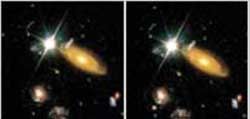Saturday, February 19, 2005
blinding signs flap flicker flicker flicker blam pow pow
something big happened up there in the sky a few weeks ago:
Brightest Explosion Ever Observed Overwhelms Telescopes
Scientists have detected a flash of light from across the Galaxy so powerful that it bounced off the Moon and lit up the Earth's upper atmosphere.
This "giant flare" was the brightest explosion ever detected from beyond the Solar System. For over a tenth of a second the remarkable flare was actually brighter than a full moon.
NASA and European satellites and ground-based telescopes around the world detected the giant flare on 27 December 2004. Scientists from twenty institutes joined the observations.
pretty spectacular, right? and the boffins over at the hubble centre caught the event in all its spectacular glory. check out these stunning shots:



one of the interesting aspects of the explosion is the fact that the light detected from the giant flare was far brighter in gamma rays than visible light or x-rays. it was probably created by an unprecedented eruption on the surface of an exotic neutron star which is classed both as an ultra-magnetic magnetar and as a soft gamma repeater (sgr). makes you think, right?
a number of important questions arise from this discovery:
1 are some gamma ray bursts (thought to be very distant black-hole-forming star explosions) actually from neutron star eruptions in nearby galaxies?
2 what mechanism could unleash so much energy from a magnetar?
3 could an even larger influx of gamma rays have caused mass extinction on earth in the past?
dr rob fender of southampton university had this to say:
"This is a once-in-a-lifetime event. We have observed an object only 20 kilometres across, on the other side of our Galaxy, releasing more energy in a tenth of a second than the Sun emits in 100,000 years."
dr bryan gaensler of the harvard-smithsonian center for astrophysics mumbled this:
"The next biggest flare ever seen from any soft gamma repeater was peanuts compared to this incredible December 27 event. Had this happened within 10 light years of us, it would have severely damaged our atmosphere and possibly have triggered a mass extinction. Fortunately there are no magnetars anywhere near us."
dr maura mcLaughlin of the university of manchester opened her gob and this came out:
"These neutron stars have magnetic fields hundreds of times more powerful than any other objects in the universe. We may be seeing a massive release of magnetic energy during a 'starquake' on the surface of the object."
heavy shit, i think you'll agree. and check out that date, 27 december... ring a bell? right, the tsunami. i may well have to get the manho research group (msg) cranked up next week to discover the obvious links between the two cataclysmic events.
incredible space-type photo of syd barrett

afterthought
southampton university?
Ω
Brightest Explosion Ever Observed Overwhelms Telescopes
Scientists have detected a flash of light from across the Galaxy so powerful that it bounced off the Moon and lit up the Earth's upper atmosphere.
This "giant flare" was the brightest explosion ever detected from beyond the Solar System. For over a tenth of a second the remarkable flare was actually brighter than a full moon.
NASA and European satellites and ground-based telescopes around the world detected the giant flare on 27 December 2004. Scientists from twenty institutes joined the observations.
pretty spectacular, right? and the boffins over at the hubble centre caught the event in all its spectacular glory. check out these stunning shots:



one of the interesting aspects of the explosion is the fact that the light detected from the giant flare was far brighter in gamma rays than visible light or x-rays. it was probably created by an unprecedented eruption on the surface of an exotic neutron star which is classed both as an ultra-magnetic magnetar and as a soft gamma repeater (sgr). makes you think, right?
a number of important questions arise from this discovery:
1 are some gamma ray bursts (thought to be very distant black-hole-forming star explosions) actually from neutron star eruptions in nearby galaxies?
2 what mechanism could unleash so much energy from a magnetar?
3 could an even larger influx of gamma rays have caused mass extinction on earth in the past?
dr rob fender of southampton university had this to say:
"This is a once-in-a-lifetime event. We have observed an object only 20 kilometres across, on the other side of our Galaxy, releasing more energy in a tenth of a second than the Sun emits in 100,000 years."
dr bryan gaensler of the harvard-smithsonian center for astrophysics mumbled this:
"The next biggest flare ever seen from any soft gamma repeater was peanuts compared to this incredible December 27 event. Had this happened within 10 light years of us, it would have severely damaged our atmosphere and possibly have triggered a mass extinction. Fortunately there are no magnetars anywhere near us."
dr maura mcLaughlin of the university of manchester opened her gob and this came out:
"These neutron stars have magnetic fields hundreds of times more powerful than any other objects in the universe. We may be seeing a massive release of magnetic energy during a 'starquake' on the surface of the object."
heavy shit, i think you'll agree. and check out that date, 27 december... ring a bell? right, the tsunami. i may well have to get the manho research group (msg) cranked up next week to discover the obvious links between the two cataclysmic events.
incredible space-type photo of syd barrett

afterthought
southampton university?
Ω